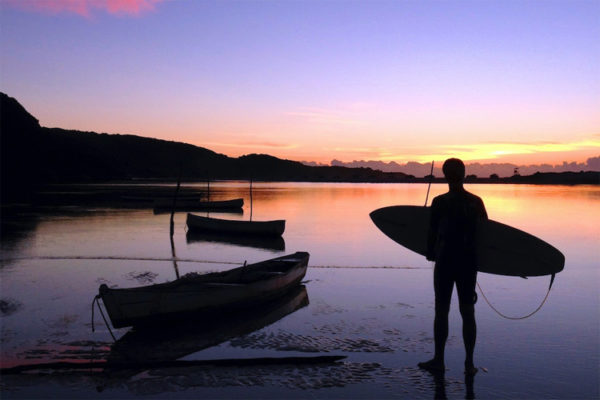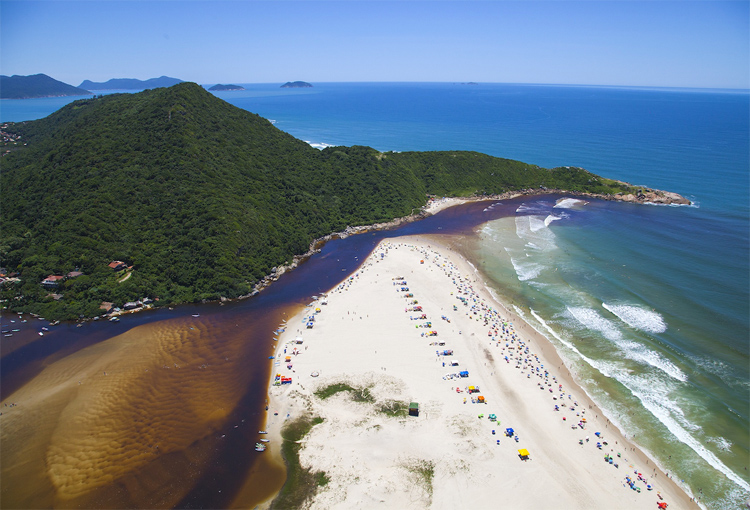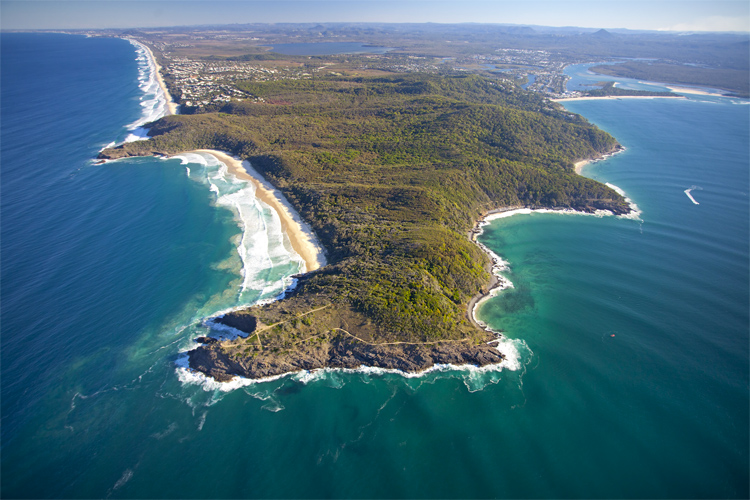Two Brazilian researchers studied the impact of surf tourism on the local economy of Guarda do Embaú, a World Surfing Reserve.
Marcos Abilio Bosquetti and Marcos Antônio de Souza wanted to quantify the economic impact surfing and surf resources have on their community.
They believe that understanding the benefits of a world-class surf spot in the local economy is essential in guiding policymakers in the right direction.
Guarda do Embaú is a small village located adjacent to the Serra do Tabuleiro State Park, the largest conservation area in the state of Santa Catarina, which boasts a stunning natural environment, including the powerful Da Madre River coming from the mountain and flowing into the sea, an intact estuary ecosystem, and a mature sand dune system.
The village, also known as “Guarda,” belongs to the City of Palhoça, and it is only 40 miles south of Florianopolis Island, the capital city of the state of Santa Catarina, southern Brazil.
Guarda’s world-class surf spot attracts surfer tourists from Brazil and abroad.
The Surf Spots
Surfers visiting Guarda do Embaú can enjoy three surf breaks: Pico do Canto (the corner), Pico do Meio (the middle), and Pico da Prainha (the little beach).
The best months for surfing are during the rainy season (summer and part of fall), although waves are consistent throughout the year.
During part of the winter and spring seasons, lucky surfers can spot Southern Right Whales from their surfboards while surfing at Guarda do Embaú.
Pico do Canto (the corner) is the most well-known wave of Guarda do Embaú. It is formed on the south side of the coast in front of the Da Madre River mouth.
In the rainy season, this point break forms long and tubular waves. It is a world-class powerful left-hand wave for experienced surfers.
Pico do Meio (the middle) is a right and left-hand beach break with fast tubes in the middle of Guarda beach for intermediate and advanced surfers.
Pico da Prainha (the little beach) is located on the north side of the coast of Guarda and is accessible by a beautiful half-hour trail that starts at the tiny downtown of Guarda Village and reaches a beautiful pristine beach surrounded and protected by the coast.
After walking through the tropical forest, surfers will find a white sandy beach and a right-hand point break wave suitable for intermediate and advanced surfers.
Guarda do Embaú has hosted local, regional, and national surfing competitions such as the 2007 Rip Curl Groom Search when future world champions Gabriel Medina and Filipe Toledo reached the podium.
Guarda Village used to be home of the Brazilian surfing legend, Ricardo dos Santos (in memoriam). The history of surfing in Brazil can definitely not be written without mentioning Guarda do Embaú.
Guarda is also a multi-generational fishing village with a deep inherent respect for its coastal resource.
From May to July, Guarda do Embaú beach closes down for artisanal mullet fishing, which means that surfing is not allowed in that beach.
During the fishing season, surfers can only enjoy the Pico da Prainha.
On October 27, 2016, Save the Waves Coalition officially nominated Guarda do Embaú into the prestigious network of World Surfing Reserves (WSR).
This designation is an international recognition of its unique attributes: natural beauty, sensitive ecosystems, world-class surfing waves, surf culture, and local tradition of artisanal fishing.
The nomination of Guarda do Embaú as the 9th World Surfing Reserve, and the first in Brazil aims to empower the local community initiatives toward the preservation of this surf paradise for future generations.
The total area of this World Surfing Reserve is 2,5 square kilometers embracing Guarda do Embaú Beach, Prainha Beach, the Da Madre River mouth, and the Coast of Guarda (Gungel, Rosa & Bosquetti, 2017).
After two years of stewardship planning and empirical studies in Guarda do Embaú, the official ceremony and celebration was hosted between October 25 – 27, 2019, when Save The Waves and the Local Stewardship Council officially dedicated Guarda do Embaú as the 9th World Surfing Reserve and the first in Brazil.
The dedication also hosted the I Pan-American Wave Conference in which the results of two empirical studies carried out during 2018 and 2019 on surf tourism, and on the Da Madre River, water quality were presented to an audience of 250 people, representing all stakeholders: local and state politicians, government agencies, surf celebrities, environmental NGOs, the chamber of commerce, the local community association, and academic researchers.
Guarda do Embaú WSR has inspired the creation of a National Surfing Reserve Program to be implemented in Brazil in collaboration with Save The Waves Coalition.
Threats to Guarda do Embaú
Local Stewardship Council of Guarda do Embaú World Surfing Reserve has identified three main threats to the pristine ecosystem and the future of surfing in this area: coastal development, lack of an adequate sewage sanitation system, and agricultural pesticides found in Da Madre River (Gungel, Rosa & Bosquetti, 2017).
The current zoning regulations allow for new construction on private property holdings at Guarda do Embaú.
In the last few years, two large-scale condominium projects have been proposed to the Palhoça City Council. Harmful coastal development threatens the ecological habitat of Guarda do Embaú.
There is a very limited, precarious, and outdated coastal sewage infrastructure system to deal with liquid and solid waste at Guarda do Embaú.
The absence of an adequate sewage sanitation system is a real threat to the local ecosystem in the form of water pollution, and consequently, to surfing.
Da Madre River plays a crucial role in forming strings of dunes and sandbanks.
The dunes help stabilize the coastline, and the sandbanks produce quality waves along Guarda beach.
Before flowing into the sea, this powerful river forms in the mountains of the Serra do Tabuleiro State Park and supplies water for agricultural food production and industrial processes in neighboring districts of Guarda do Embaú.
The agricultural pesticides found in the river threaten the water quality and biodiversity along the river.
This Surfonomics study aims to estimate the direct contribution of surf tourism on the local economy of Guarda do Embaú in order to empower the local community and their initiatives in dissuading coastal uses and projects that might endanger the wave quality and surrounding marine environment.

The Surfonomics
This study applied surf economics, informally known as Surfonomics, a method that uses direct expenditure data from visiting surfer tourists to estimate the economic value that a world-class wave brings to the local community.
The Surfonomics model, created in California, was adapted to the Brazilian context, and some features unique to this study were added.
Surfing is practiced by approximately 35 million people worldwide (O’Brien & Eddie, 2013).
In search of perfect waves, surfers are regularly engaging in surf tourism across the globe (Buckley, 2002; Ponting, 2009), impacting thousands of coastal communities (Martin & Assenov, 2012; Ponting & O’Brein, 2015; Mach & Ponting, 2018).
As harmful coastal development and pollution threaten surf spots, the evaluation of economic benefits derived from surfing, informally known as Surfonomics, has been used by internationally renowned enviro-surf NGOs such as the Surfrider Foundation and Save The Waves Coalition to justify the protection and conservation of surf resources.
Surf economics or Surfonomics applies natural resource economics to better understand the economic value of waves and surfing to local communities, as well as the consumer surplus that surf breaks provide to millions of surfers (Nelsen, 2012).
Surfonomics has contributed to Save The Waves’ World Surfing Reserves Program as an advocacy mechanism to influence government policies and help decision-makers make better choices to protect key environmental, cultural, economic, and community attributes of world-class surf breaks and their surrounding areas (Save The Waves, 2019).
Over the past decade, Save the Waves has commissioned seven Surfonomics studies. Four of them were carried out in World Surfing Reserves: Pichilemu, Chile (Wright, Hodges & Sadrpour, 2014); Huanchaco, Peru (Hodges, 2015); Bahia de Todos Santos, Mexico (Hodges, 2015); and Guarda do Embaú, Brazil (Bosquetti & Souza, 2019). The other three were carried out in Mundaka, Spain (Murphy & Bernal, 2008); Mavericks, USA (Coffman & Burnett, 2009); and Uluwatu, Indonesia (Margules, 2014).
In Australia, a similar study carried out by Neil Lazarow was commissioned by the Gold Coast City Council to support the city’s shoreline management plan (Lazarow, 2009).
All of these studies applied the Direct Expenditure Method of economic evaluation to estimate the market value of surfing for the local economy. The results of these eight studies sum up to US$250 million per year.
Surfing also produces significant non-market value, which comes from the welfare and benefits that surfing provides to millions of surfers, but cannot be measured by expenditure methods.
The most common type of non-market value studied in surfing is consumer surplus, estimated by the Travel Cost Method.
It represents the aggregate willingness-to-pay above and beyond what people are currently paying to reach the surf location (Scorse & Hodges, 2017).
Chad Nelsen, CEO of the Surfrider Foundation, applied the Travel Cost Method to estimate the nonmarket value of surfing at Trestles, California and found an average consumer surplus of surfing to be US$138.00 per person per visit (Nelsen, 2012).
The non-market value of surfing can also be estimated by the Hedonic Price Method.
As surfers choose to live close to surf spots, they have no travel costs. However, they pay much higher prices for a house.
Therefore, part of the non-market value of surfing would be capitalized into real estate value.
Scorse, Reynolds & Sackett (2015) applied the Hedonic Price Method to study the impact of surf breaks on home prices in Santa Cruz, California and found that beach houses close to surf spots are worth hundreds of thousands of dollars more than similar beach houses far from surf spots.

What’s at Stake
Results of this empirical study on the spending patterns and behaviors of surfer tourists visiting Guarda do Embaú World Surfing Reserve (WSR) show that on average a surfer tourist spends US$61.00 per day in the village, which is in between the US$45.00 found in Huanchaco WSR, Peru (Hodges, 2015) and the US$111.00 found in San Miguel WSR, Mexico (Hodges, 2014), but much less than the US$159 found in Pichilemu WSR, Chile (Wright, Hodges & Sadrpour, 2014).
A direct comparison among these results may be jeopardized by differences between countries related to living costs, per capita income, and local currency exchange rates.
It is also important to notice that transportation costs to reach Guarda do Embaú were not included in the expenditure figures, as it has very little to no impact on the local economy of the village.
This Surfonomics study is unique for considering the average number of partners traveling with the surfer tourist to Guarda do Embaú.
Although they might not surf, the money they spend in the village contributes directly to the local economy as well.
Research findings suggest that in 2018 surfing attracted 3,856 surfer tourists to Guarda do Embaú.
On average, they brought two travel partners with them on the trip to Guarda and stayed for six days in the village, spending on average US$61.00 per person per day.
Based on these findings, it can be estimated that in 2018 surf tourism contributed approximately US$4.2 million to the local economy of Guarda do Embaú.
In the Brazilian context, this figure is a very significant contribution of surf tourism to a small village of only 800 inhabitants.
It has a much more important impact than an equivalent figure in a developed economy such as the USA or Australia.
Comparing with a tourism study conducted by Santur (2019) with tourists in general at the City of Palhoça, where Guarda do Embaú is located, surfer tourists and their travel partners account for approximately 44 percent of the tourists visiting Guarda, but they spend on average twice as much as tourists in general and are responsible for around 77 percent of the tourism contribution to the local economy of Guarda do Embaú.
It also shows that surfer tourists have, on average, a higher level of education and income than the tourists in general.
If researchers had to describe the profile of the surfer tourists visiting Guarda do Embaú based only on the sample and findings of this Surfonomics study, they would say that they are, on average, 34 years old and that only 8.7 percent are female.
67.9 percent of the surfer tourists have education at or above the university level, and 91.0 percent of them are intermediate to professional surfers.
For 98.1 percent of the surfer tourists, surfing is a primary or secondary factor influencing their decision to visit Guarda.
In terms of their perceptions of Guarda do Embaú as a surf destination, 97.8 percent of the surfer tourists perceive Da Madre River as highly relevant or relevant to the quality of the waves, and the three most pointed out factors that would negatively impact their decision to return to Guarda do Embaú are water pollution, trash, and sewage.
This first Surfonomics study carried out in Brazil used the most basic form of economic valuation known as Direct Expenditure Method to estimate the contribution of surf tourism to the local economy of Guarda do Embaú, so it does not capture the entire economic value of surfing.
Further studies should use the Travel Cost Method and the Hedonic Price Method in the real state market to estimate the non-market value of surfing to Guarda do Embaú.
However, findings of the present study are enough to show that Guarda do Embaú is a perfect example of how a small village can benefit from and depend on the preservation of a world-class wave.
Therefore, decision-makers should take into account that surf tourism is a non-extractive coastal resource that makes a significant contribution to the local economy of Guarda do Embaú.

The Results
Using the Direct Expenditure Method of economic analysis, researchers were able to quantify that surfer tourists visiting Guarda do Embaú spend, on average, US$61.00 per day.
Research findings indicate that in 2018 surfing attracted 3,856 surfer tourists to Guarda do Embaú.
On average, they brought two travel partners with them and stayed for six days in the village.
The result of the multiplication of these variables suggests that in 2018 surf tourism contributed approximately US$4.2 million to the local economy, which is a very significant contribution to a village of 800 inhabitants considering the Brazilian socioeconomic context.
Comparing this Surfonomics study with a study of tourists in general at the City of Palhoça, where Guarda do Embaú is located (Santur, 2019), surfer tourists have, on average, a higher level of education and income, and spend twice as much as the general tourists.
It also suggests that surfer tourists and their travel partners account for 44 percent of the tourists visiting Guarda do Embaú and are responsible for around 77 percent of the tourism contribution to the local economy.
This empirical study clearly shows that the economic impact of surf tourism on the local economy of Guarda do Embaú is substantial and should be considered when taking any coastal management decision.
It also shows that water pollution, trash, and sewage are the main factors that would negatively impact the surfer tourists’ decision to return to Guarda do Embaú.
Guarda do Embaú is a perfect example of how a small village can benefit from and depend on the preservation of a world-class wave.
As harmful coastal development, sewage, and agricultural pesticides found in Da Madre River threaten surfing and coastal resources in Guarda do Embaú, it appears that urgent action is needed to preserve this incredible surf ecosystem for future generations.
Excerpts taken from “Surfonomics Guarda do Embaú, Brazil” by Marcos Abilio Bosquetti and Marcos Antônio de Souza





Recent Comments